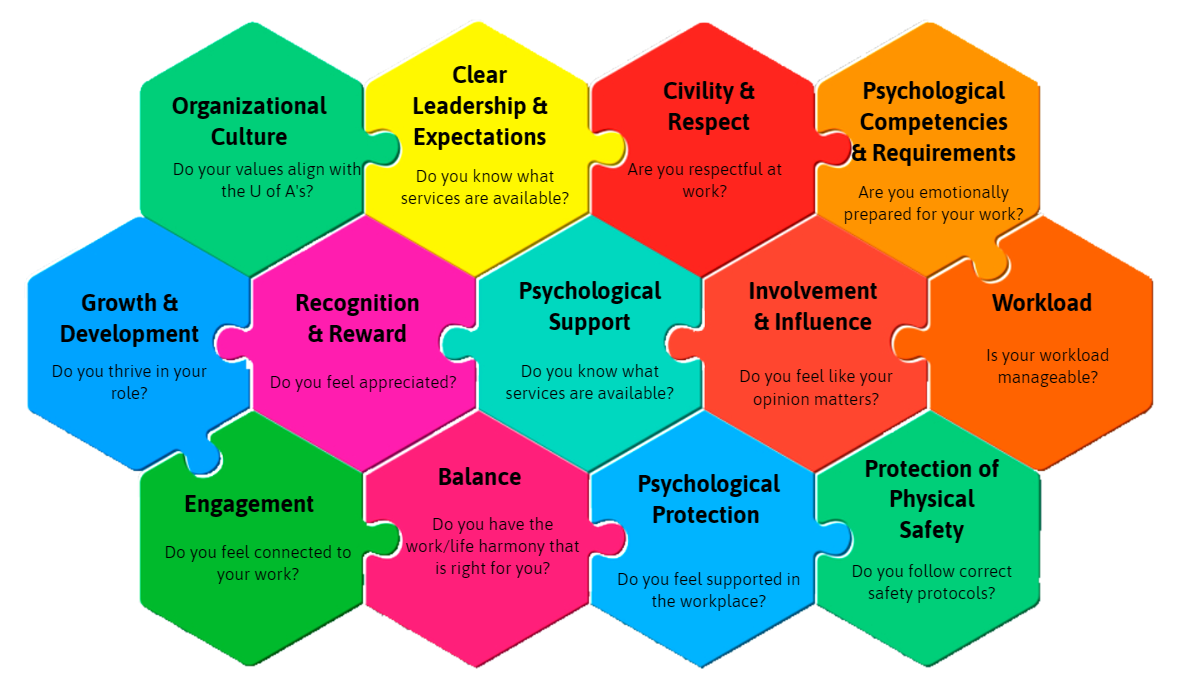Creating Psychologically Safe Workplaces

Managers and leaders play a critical role in creating psychologically safe workplaces. A workplace with good psychological health is one in which a state of well-being exists, where faculty and staff realize their own abilities, can cope with the normal stresses of life, can work productively, and are able to make a contribution to the university community.
Psychologically healthy and safe workplaces:
- support individuals, departments and faculties in creating a respectful, healthy and engaging work and learning environment.
- acknowledge psychological risk factors where they exist.
- provide the tools to positively, effectively and efficiently address any identified issues.
A psychologically healthy workplace is one where every reasonable effort is made to promote mental health through awareness, resources and education.
A psychologically safe workplace is one where every reasonable effort is made to prevent harm to mental health through negligent, reckless or deliberate conduct.
University Framework
The university has put together an overall framework as well as leader - and staff - specific frameworks. The goal of these frameworks is to support departments, faculties and work units in achieving a psychologically healthy and safe workplace. Managers and supervisors that prioritize the health and safety of their workplace see many benefits including:
- Improved employee engagement.
- Increased sustainability.
- Improved recruitment and retention.
- Increased health and safety.
- Reduced absenteeism.
- Reduced presenteeism (people being at work but not being productive, for a variety of reasons).
- Reduced benefits costs.
- Reduced workers compensation board (WCB) claims and disability rates.

Psychosocial Risk Factors
Managers and supervisors can review the following 13 factors to help promote health and reduce risk:
1. Psychological support: an environment where psychological and mental health concerns are supported and responded to appropriately.
Psychological Support
2. Organizational culture: the environment is characterized by trust, honesty and fairness.
Organizational Culture
3. Clear leadership and expectations: effective leadership exists that enables individuals to know what to do, how their work contributes to the goals of the organization, and if change is approaching.
Clear Leadership and Expectations
4. Civility and respect: staff and faculty are respectful, considerate and collegial with one another.
Civility and Respect
5. Psychological competencies and requirements: a staff member’s interpersonal/emotional competencies and job skills are appropriate for the position.
Psychological competencies and requirements
6. Growth and development: staff members receive encouragement and support in the development of interpersonal, emotional and job skills.
Growth and development
7. Recognition and reward: acknowledgement and appreciation of staff member’s efforts in a fair and timely manner.
Recognition and reward
8. Involvement and influence: individuals are included in discussions about how work is done, how decisions are made, and the impact of those decisions on the work
Involvement and influence
9. Workload management: tasks and responsibilities can be accomplished successfully within the time available.
Workload management
10. Engagement: staff members enjoy and feel connected to their work and are motivated to do a good job.
Engagement
11. Balance: recognition and support for balance between the demands of work, family and personal life.
Balance
12. Psychological protection: an environment in which psychological safety is ensured.
Psychological protection
13. Physical safety: appropriate action to protect employees’ physical safety at work.
Physical safety
More resources that you may find helpful:
- Working Through It
- Managing Mental Health Matters
- How Your Management Style Contributes to Staff Wellbeing and Performance
For additional resources and learning opportunities related to each risk factor check out our support inventory .
The university’s psychologically healthy and safe workplace material is designed to assist in raising awareness of the importance of workplace factors that contribute to psychological safety, increase the understanding of why these factors are important, and to direct campus members to resources, services, processes and policies that can help maintain or increase their level of proficiency in these concepts. This framework has been developed in accordance with the national standard of Canada for Psychological health and safety in the workplace .